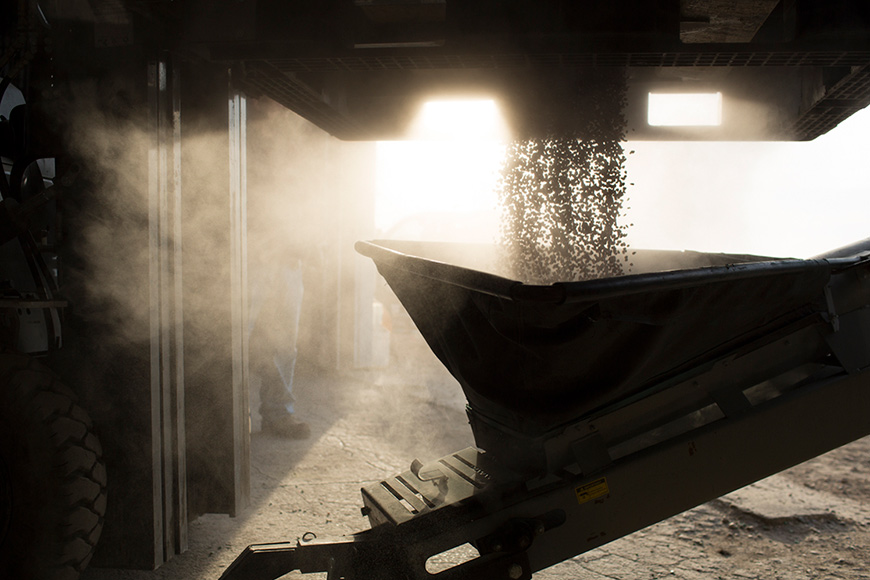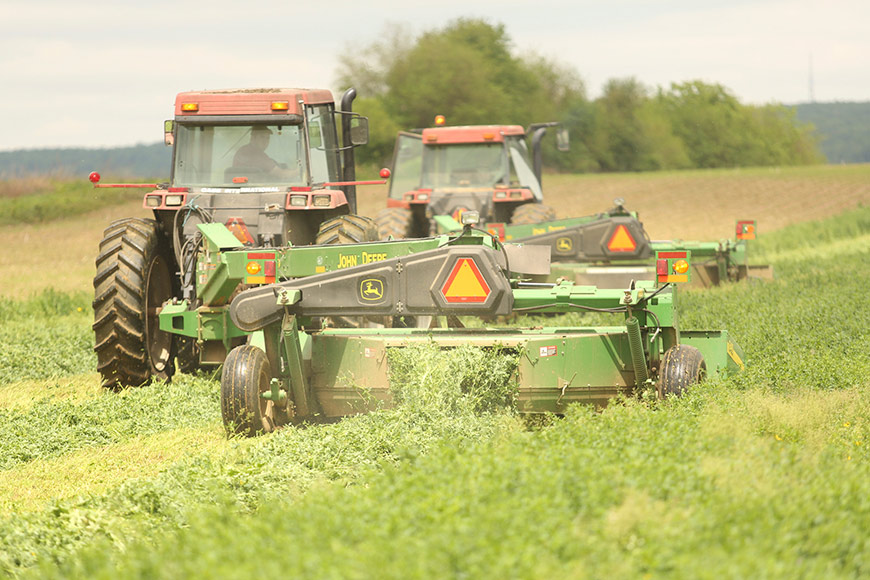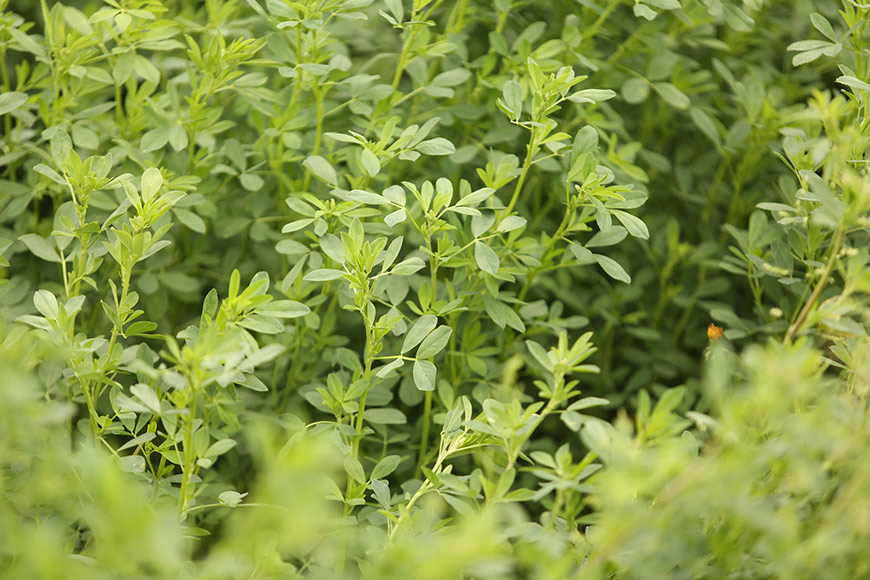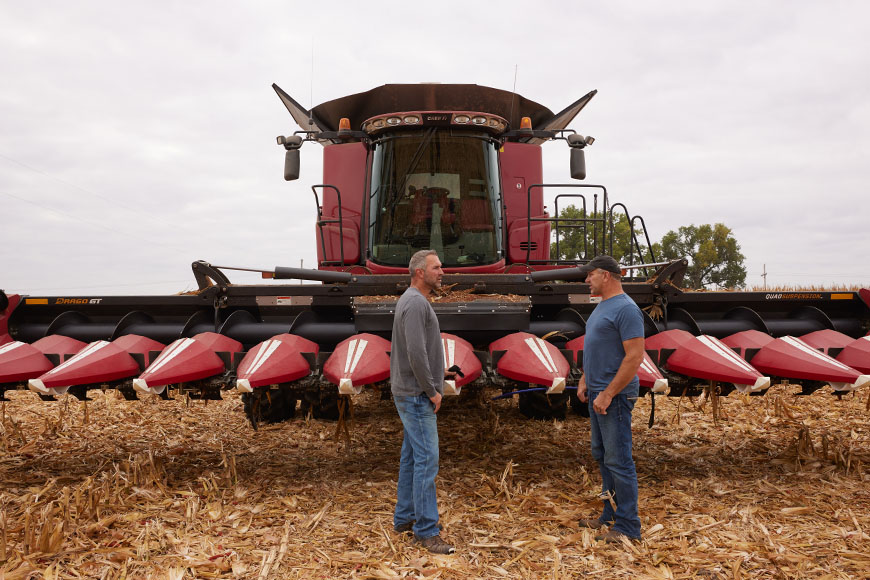What’s Holding Back Your Alfalfa Yield & Quality?

It’s an exciting time in alfalfa. Today’s growers have many tools in their toolboxes to push alfalfa to its genetic potential. They are paying closer attention to the details that move the mark for improvements in yield and forage quality, including increased protein and digestible fiber content. Consider the following tools and strategies to maximize your alfalfa’s potential.
Stand Establishment
Precision Seeding: Thick and uniform stands produce higher yield potential. Planting at the proper depth is important. Seeds planted too deep may reduce emergence and stand density. In dry conditions, seeds planted too shallow may dry out. Using seeding equipment to control depth and press wheels to firm soil over and around seeds can help produce better stands. Prior to seeding, rollers with corrugations can help crush lumps and provide improved seed-to-soil contact. Smooth rollers may not provide the ideal soil lump crushing effect. A large portion of stand disappointment can be eliminated by paying more attention to precision seeding. Seeding rates need to be high enough to ensure a minimum stand density of 30-35 plants per square foot. An average of 18-22 pounds of seed per acre paired with proper management can provide a productive stand. Seeding alfalfa into warm soils of 50 degrees or higher can help produce uniform germination. Fungicides included in seed treatments help promote strong stand establishment in unfavorable soils, especially during cool and wet conditions.
Herbicide Carryover: Poor alfalfa establishment or stunted alfalfa may be caused by previous corn or soybean herbicides. Avoiding this issue requires proactive planning prior to corn and soybean planting. This allows you to choose corn and soybean chemistries that won’t harm future alfalfa stands due to carryover residue in the soil.
Value of Roundup Ready® Alfalfa: Glyphosate applied to Roundup Ready alfalfa (RR) is an excellent tool to help growers establish and maintain weed-free alfalfa stands. As most problem weeds in alfalfa are susceptible to glyphosate, RR technology can provide a valuable weed control tool and important crop safety to alfalfa producers. Keep in mind, the risk of RR weed resistance does not increase simply from glyphosate applications. Resistant weeds must be present and go to seed to complete the weed resistance cycle. Mechanical crop harvest by removal of most immature weeds will upset the weed growth cycle before the mature seed stage can occur. Conventional residual soil chemistry may be needed on a case-by-case basis to address RR resistance concerns.
Soil Fertility
Many farmers have room to improve their soil fertility programs. Primary, secondary and micronutrients are all needed to maximize plant performance. When these nutrients are missing, it can cost producers in lost yield. The nutrients below impact alfalfa performance and are important to manage. Your agronomist can help with these targets but here are some helpful guidelines.
Manage soil fertility by taking regular soil tests and follow the recommendations provided. These tests are helpful for monitoring potassium, phosphorous and soil pH.
Potassium (K) is an essential plant nutrient needed for nearly all plant functions. It interacts with plant enzymes to initiate processes like photosynthesis, protein synthesis, starch formation and water uptake. Potassium also provides the “antifreeze” needed to regulate cell water content for winterhardiness. Potassium fertilizer needs to be applied to most Midwestern and Eastern soils on an annual basis. Potassium is extracted at a rate of about 50 pounds per ton of harvested forage.
Phosphorus (P) levels for many growers who also raise livestock can become excessive because the manure they apply to their fields contains high levels of it. Fields that do not receive manure applications need to be tested and managed to ensure a sufficient supply. Phosphorus deficiency is more common on many commercial alfalfa hay farms.
Soil pH is critical because it drives nitrogen fixation and prevents nutrients like P and K from becoming locked up in the soil. Neutral pH around 6.8-7.2 is needed to maximize alfalfa yield. When soil pH is below optimum, yield loss occurs. Every 0.1 pH below optimum can result in 0.10 DM T/Ac yield loss. Soil pH variations can be significant within a field so good soil tests and variable-rate lime applications are helpful. Apply lime one year before seeding alfalfa to provide enough time for the soil pH to increase.
To manage secondary and micronutrients, tissue tests should be used. For alfalfa, it’s important to pay close attention to sulfur and boron. Nutrient percentage in the tissue or parts per million (ppm) in the plant can give you a snapshot of what’s going on so you can make a quick decision to correct levels in-season.
Sulfur (S) is an important element needed to construct protein. If your fields are limited on sulfur, alfalfa protein levels can be lacking, which is critical when trying to raise a high-protein crop for dairy or livestock production. Applied sulfur is particularly important now, as minimal amounts are deposited from rainfall. Since sulfur will leach, it can be highly variable in areas of high rainfall like the Midwest and East because rain pushes it deep into the soil where it may not be extractable. Sulfur fertilizer should be applied annually at a rate of about 5 pounds per ton of forage produced as calcium sulfate (gypsum), ammonium sulfate (AMS) or elemental sulfur (S) can be easily applied with potassium (K) fertilizer applications.
Boron (B) is a micronutrient that can be deficient in alfalfa fields, especially those that are sandy or low in organic matter. Like sulfur, boron leaches through the soil profile so in high-rainfall areas, boron needs to be replaced annually to produce a high-yielding crop. We recommend growers apply about 1.5 - 2.0 pounds per acre of boron annually with their potash fertilizer application. A foliar application of boron like MAX-IN® Boron with a potato leafhopper (PLH) spray application is an excellent mid-summer supplement for alfalfa fields.
The NutriSolutions® App is a convenient tool to use in evaluating the health of your crops and soil. Fueled by insights gathered from tissue and soil samples, it helps you quickly identify hidden nutrient needs before yield may be compromised.
Strategic Crop Protection
Fungicides: Implementing a strong fungicide plan is important for taking alfalfa yield and forage quality to the next level. University data shows that fungicide applications made on first- and second-cut alfalfa and in delayed harvest management (>30 days) have the highest return. Apply fungicide when alfalfa is 6” to 8” tall to protect the leaves for additional quality and yield potential.
Insecticides: In the Plains and Midwest, it’s important to stay ahead of alfalfa weevils. Scout for weevils and take action if 40% of plants show any pinhole feeding. Matching the cutting date to early larval development can also offer control. In high infestations and early feeding, insecticide applications will be needed to keep this pest in check. After first cutting, monitor second crop regrowth to make sure no feeding is still underway. In the Midwest and East, the potato leaf hopper (PLH) is an important insect to control. It thrives in hot summer conditions in July and August. Pay special attention to new seedings as they can be devastated by PLH. Scout using a sweep net for PLH and take action if you find them in summer regrowth crops and new seedings. The crane fly is a new insect we are watching in some Eastern regions. Research is underway to determine the impact and control of this potential pest.
Alfalfa Seed Genetic Potential
The breeding and selection process for new alfalfa genetics moves at a fast pace and new varieties often outperform existing ones quickly. This creates a large gap between average and elite genetics. For example, new varieties offer the latest in improved disease resistance, which creates a notable difference in performance because seedling root diseases – multi-race Aphanomyces root rot and Pythium – stem diseases like Anthracnose and leaf diseases have a direct impact on forage yield. In addition to base genetics, adding the HarvXtra® alfalfa with Roundup Ready trait provides the greatest harvest flexibility that addresses the yield vs. quality tradeoff of conventional alfalfa. This is accomplished by reducing the cross-linking of non-digestible lignin with the digestible fractions in the plant. Excessive lignin content reduces forage digestibility and narrows the high-quality harvest window. Extending the harvest window >30 days can provide additional yield and stand persistence potential. The Roundup Ready alfalfa trait provides excellent stand establishment for a quick, strong and weed-free alfalfa stands with superior crop safety.
Harvest
Harvest Timing: It’s tempting to rely on the calendar for a cutting decision, but the focus should be on plant height. Plant height is an indication of stem fiber accumulation and digestibility. A simple yet effective method is to take first-cut alfalfa at about 28 inches tall. Relative Forage Value (RFV) and digestibility can also be predicted using a PEAQ/PAY stick, available from your local CROPLAN® alfalfa seed retailer. Cutting at 28 inches helps ensure maximum yield potential before lodging risk increases. In a typical year, the 28-inch benchmark will lead to a harvest date between the third or fourth week of May in the upper Midwest. However, there are a wide variety of factors that can change that from year to year. Under normal spring conditions, alfalfa will grow about one inch per day. Lyons et al. (2016) reported each inch provides an average of 126 pounds of dry matter yield per acre at a stem density >50 stems/ft2. You can calculate the target harvest height and date using measurements from your PEAQ/PAY stick.
Mechanical Harvest: It’s important to keep in mind that cutting, merging/raking, chopping/baling and hauling can all result in additive leaf losses, which can be a quality and a yield loss. These losses are difficult to quantify because leaf fragments simply disintegrate and scatter on the soil surface or are lost as “leaf vapor” at the chopper during harvest. Better understand your leaf percentages so you can make management adjustments accordingly with the newly available Calibrate® HQ Leaf Percent Test.
Wheel Tracks: Finally, the number of wheel tracks and loads per wheel have increased on many farms. Random high-load traffic has the potential to reduce alfalfa yield. Random wheel traffic covers as much 80-90% of most fields. Reducing random traffic patterns that crush alfalfa crowns and compact the soil may help producers reduce this yield gap.
Alfalfa’s genetic potential has improved more over the last decade than actual on-farm yield performance has. When managed correctly, alfalfa has great profit potential, and these tips should help you tap into more of it. To dive deeper into alfalfa management strategies, contact your local CROPLAN seed retailer.
All photos are either the property of WinField United or used with permission.
© 2022 WinField United. Important: Before use always read and follow label instructions. Crop performance is dependent on several factors many of which are beyond the control of WinField United, including without limitation, soil type, pest pressures, agronomic practices and weather conditions. Growers are encouraged to consider data from multiple locations, over multiple years and to be mindful of how such agronomic conditions could impact results. CROPLAN, MAX-IN, NutriSolutions and WinField are trademarks of WinField United. All other trademarks are the property of their respective owners.






